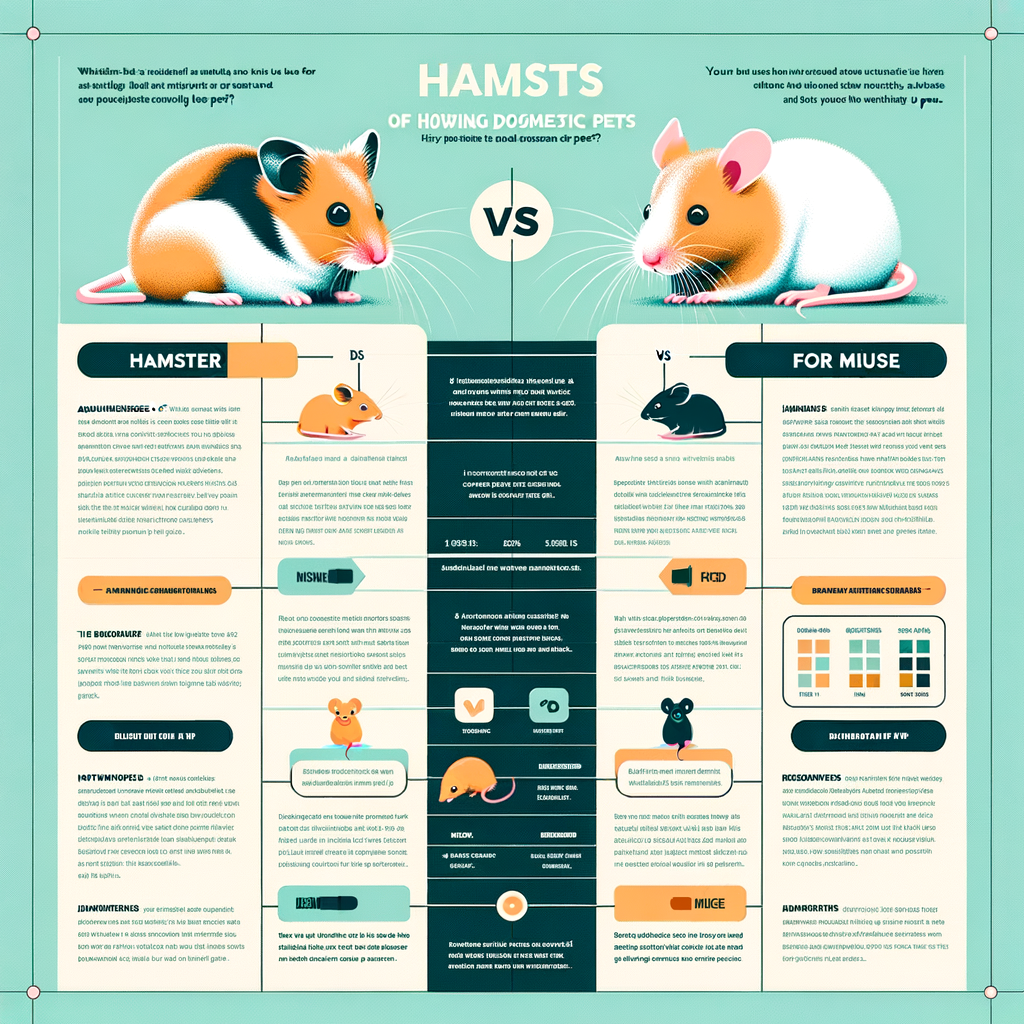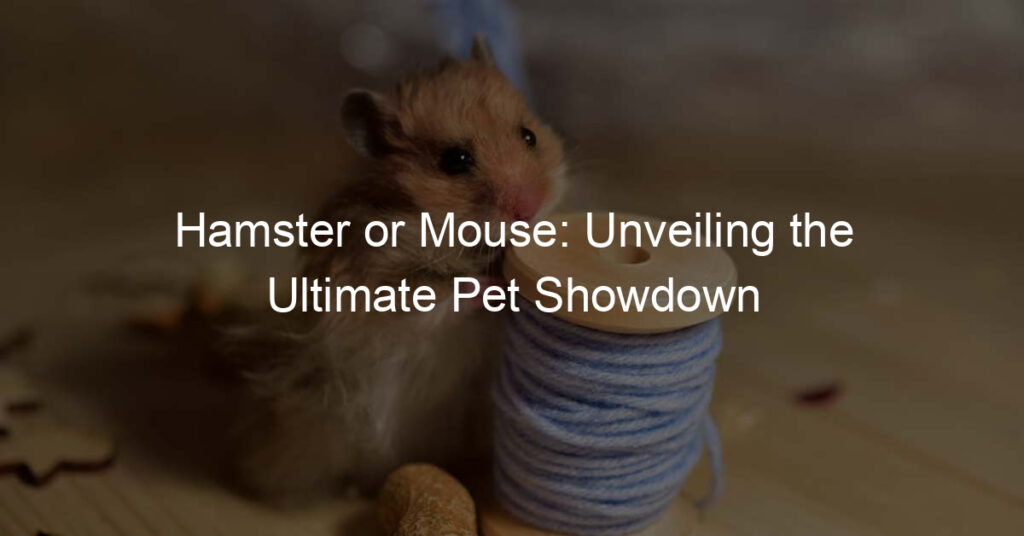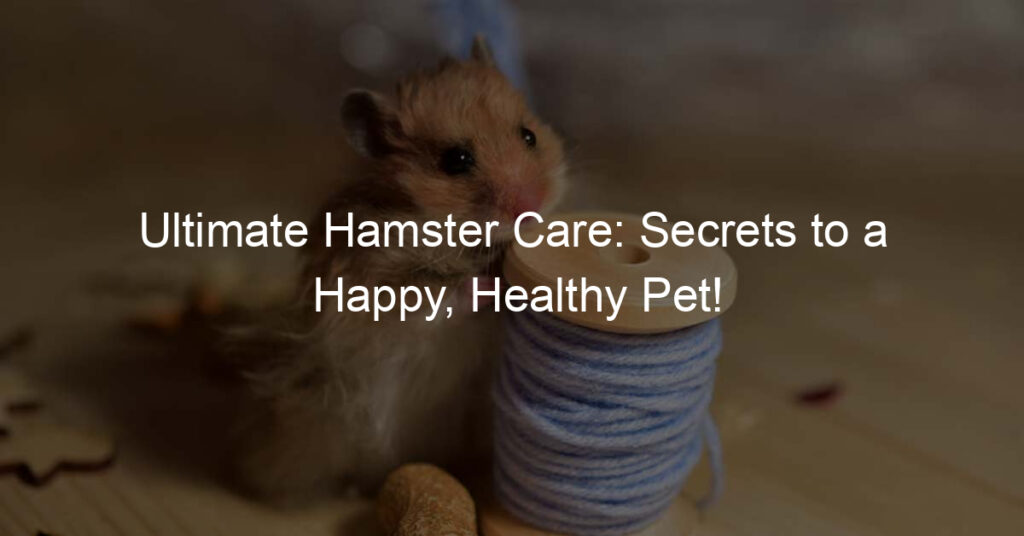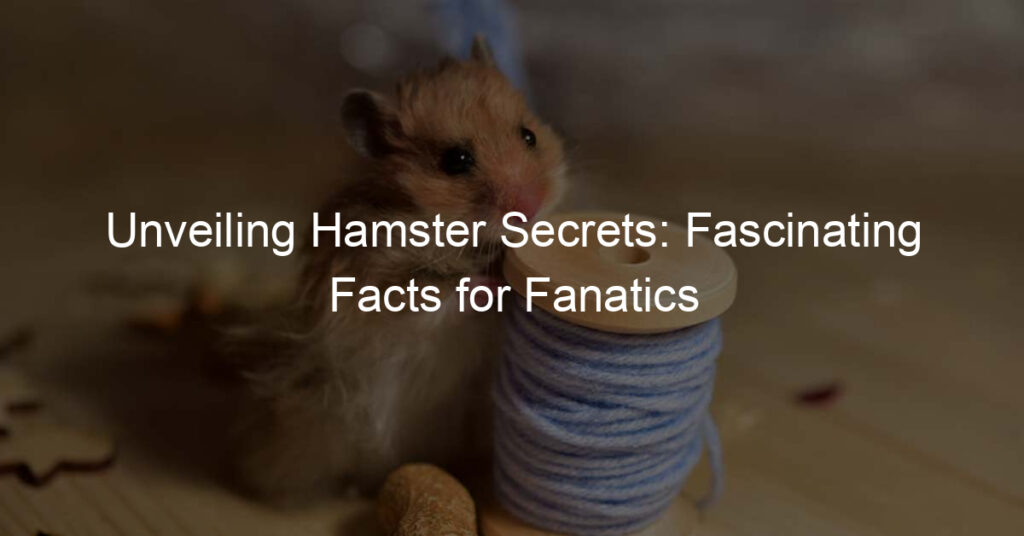
Introduction: Hamster or Mouse as a Pet
Choosing a pet can be a challenging task, especially when the options are as adorable as a hamster or a mouse. This article aims to provide a comprehensive guide to help you make an informed decision.
- Overview of the debate between hamster and mouse as pets
The debate between choosing a hamster or a mouse as a pet has been ongoing for years. Both these small mammals have their unique qualities that make them special. Hamsters are known for their cute, chubby cheeks and nocturnal habits. On the other hand, mice are appreciated for their curious nature and sociability. However, the choice ultimately depends on your personal preference and lifestyle.
- Key factors to consider when choosing a pet
When choosing a pet, it’s important to consider several factors. Here are some key points to keep in mind:
| Factor | Description |
|---|---|
| Lifestyle | Consider your daily routine and how much time you can dedicate to your pet. Some pets require more attention and care than others. |
| Space | Ensure you have enough space in your home for your pet to move around comfortably. |
| Cost | Consider the cost of food, housing, and veterinary care for your pet. |
| Longevity | Consider how long your pet is expected to live. Some pets have longer lifespans than others. |
Whether you choose a hamster or a mouse, remember that both require love, care, and commitment. Stay tuned for the next sections where we delve deeper into understanding hamsters and mice as pets, and compare them in the ultimate pet showdown.
Understanding Hamsters as Pets
Hamsters are popular pets, known for their cute, cuddly appearance and playful nature. But what makes them such a great choice for a pet? Let’s delve into the pros of having a hamster as a pet.
Pros of Having a Hamster as a Pet
There are several reasons why hamsters make great pets. Here are a few key advantages:
- Hamster’s Lifespan
- Hamster’s Behavior and Temperament
- Hamster’s Diet and Nutrition
Hamsters typically live for 2-3 years, making them a good choice for those who want a pet but are not ready for a long-term commitment. This shorter lifespan can also be beneficial for children, as it can teach them about the life cycle in a more manageable timeframe.
Hamsters are generally friendly and easy to handle, making them suitable for families with children. They are also independent animals, which means they can be left alone during the day while you are at work or school. However, they do enjoy playtime and interaction, so it’s important to spend time with them regularly.
Hamsters are omnivores, meaning they eat a variety of foods, including fruits, vegetables, and grains, as well as some types of meat. This makes feeding them relatively straightforward. They also enjoy treats and snacks, which can be used as a form of enrichment and bonding.
In conclusion, hamsters are a great choice for those looking for a pet that is low maintenance, friendly, and has a manageable lifespan. They are also a good choice for families with children, as they are easy to handle and can teach children about responsibility and the life cycle.
Cons of Having a Hamster as a Pet
While hamsters can make delightful pets, it’s important to understand that they also come with their own set of challenges. Here are some potential drawbacks to consider:
- Hamster’s Nocturnal Nature
- Hamster’s Health Issues
- Hamster’s Care and Maintenance
Hamsters are nocturnal creatures, which means they are most active during the night. This can be a problem if you’re a light sleeper or if you’re not home in the evenings to interact with them. They can make noise with their activities, like running on their wheel, which might disturb your sleep.
Hamsters can suffer from a variety of health issues, including respiratory infections, digestive problems, and tumors. Some of these conditions can be serious and require veterinary care. It’s important to be prepared for potential vet bills and to ensure you have access to a vet who specializes in small animals.
Hamsters require a clean and comfortable living environment. This means you’ll need to clean their cage regularly, provide fresh food and water daily, and ensure they have plenty of exercise opportunities. They also need a variety of toys and activities to keep them mentally stimulated. All of this requires time, effort, and money.
In conclusion, while hamsters can make wonderful pets, they do require a significant amount of care and attention. It’s important to consider these factors before deciding to bring a hamster into your home.
Hamster Care: Essential Tips
When it comes to caring for a hamster, there are three main areas to focus on: creating a suitable habitat, feeding your hamster properly, and ensuring regular health check-ups and vaccinations. Let’s delve into each of these areas.
- Creating a Suitable Habitat for a Hamster
Hamsters need a clean, spacious, and stimulating environment to thrive. A cage with a solid bottom is ideal, as wire-bottomed cages can hurt their small feet. The cage should be large enough for your hamster to run and play. A wheel for exercise, tunnels for exploration, and a quiet place to sleep are all essential. Bedding should be soft and absorbent, and changed regularly to keep the cage clean and odor-free.
- Feeding a Hamster: What and How Often?
Hamsters are omnivores, which means they eat both plant-based and animal-based foods. A balanced diet for a hamster includes commercial hamster food, fresh fruits and vegetables, and a small amount of protein from sources like cooked chicken or boiled eggs. Feed your hamster once a day, usually in the evening when they are most active. Always provide fresh water for your hamster.
- Hamster’s Health Check-ups and Vaccinations
Regular vet visits are crucial for your hamster’s health. A vet can monitor your hamster’s weight, check for signs of illness, and provide necessary vaccinations. Hamsters don’t need as many vaccinations as dogs or cats, but they do need protection against diseases like the Wet Tail, a common and serious illness in hamsters. Regular check-ups can catch health issues early, before they become serious problems.
Remember, a happy and healthy hamster is a joy to have as a pet. By providing a suitable habitat, a balanced diet, and regular vet care, you can ensure your hamster lives a long, happy life.
Understanding Mice as Pets
When it comes to small, furry pets, mice are often overlooked. However, these little creatures can make wonderful pets. Let’s explore the advantages of having a mouse as a pet.
Pros of Having a Mouse as a Pet
Mice, like any other pet, have their unique set of benefits. Here are a few reasons why mice can make great pets:
- Mouse’s Lifespan
- Mouse’s Sociable Nature
- Mouse’s Diet and Nutrition
Mice typically live for 1 to 2 years. This shorter lifespan compared to other pets can be an advantage for those who are not ready for a long-term commitment. It also allows children to learn about the life cycle in a shorter timeframe.
Mice are social animals. They enjoy the company of their own kind and can also form bonds with their human caretakers. This sociable nature makes them entertaining and engaging pets.
Mice are omnivores, which means they eat both plant and animal matter. Their diet mainly consists of grains, fruits, and vegetables, but they also enjoy the occasional insect or meat. This makes feeding them relatively easy and inexpensive.
In conclusion, mice can make wonderful pets for the right person or family. They are small, sociable, and easy to care for. However, like any pet, they require a commitment of time and resources. If you are considering a mouse as a pet, make sure you are ready to meet their needs.
Cons of Having a Mouse as a Pet
- Mouse’s Nocturnal Nature
- Mouse’s Health Issues
- Mouse’s Care and Maintenance
While mice are adorable pets, they are also nocturnal creatures. This means they are most active during the night when most people are sleeping. If you’re a light sleeper, the sound of a mouse scurrying around its cage or running on its wheel can be a disturbance. Also, children who want to play with their pet mouse during the day may find it sleeping, which can be disappointing.
Mice, like any other pet, can suffer from a variety of health issues. Some of these include respiratory diseases, skin problems, and tumors. These health problems can lead to frequent visits to the vet, which can be costly. Additionally, mice have a short lifespan of 1-2 years, which can be emotionally challenging, especially for young children.
Keeping a mouse as a pet requires a significant amount of care and maintenance. Mice need a clean and spacious cage with plenty of toys for stimulation. Their diet needs to be balanced and nutritious, and they need fresh water daily. Furthermore, mice are social animals and need interaction, either with other mice or their human caregivers. This level of care can be time-consuming and may not be suitable for everyone.
Mouse Care: Essential Tips
Proper care for your pet mouse is crucial to ensure its health and happiness. Here are some essential tips to help you provide the best care for your pet mouse.
- Creating a Suitable Habitat for a Mouse
- Feeding a Mouse: What and How Often?
- Mouse’s Health Check-ups and Vaccinations
A mouse needs a comfortable and safe habitat to thrive. A good cage should be spacious, well-ventilated, and secure. It should have enough space for your mouse to run around and play. The cage should also contain a nesting area filled with soft bedding for your mouse to sleep. Toys and exercise wheels can also be added to keep your mouse entertained and active.
Mice are omnivores, meaning they eat both plants and meat. A balanced diet for a mouse should include grains, fruits, vegetables, and a small amount of protein. Commercially prepared mouse food is also a good option as it is specially formulated to meet their nutritional needs. Mice should be fed once or twice a day, and fresh water should always be available.
Regular health check-ups are important to monitor your mouse’s health. A vet can detect any potential health issues early and provide appropriate treatment. While mice do not require vaccinations like dogs or cats, they should be regularly checked for parasites and other common health issues. Always consult with a vet if you notice any changes in your mouse’s behavior or appearance.
In conclusion, taking care of a mouse involves creating a suitable habitat, providing a balanced diet, and ensuring regular health check-ups. With proper care, your mouse can live a healthy and happy life.
Comparing Hamsters and Mice: The Ultimate Pet Showdown
When it comes to choosing between a hamster and a mouse as a pet, there are several factors to consider. One of the most important aspects is the lifespan of these animals. Let’s dive into the comparison of the lifespan of a hamster versus a mouse.
Comparison of Lifespan: Hamster vs Mouse
Knowing how long your pet might live is crucial. It helps you prepare for the commitment you’re about to make. So, let’s compare the lifespan of a hamster and a mouse.
On average, hamsters live for about 2-3 years. However, this can vary depending on the breed. For instance, Roborovski hamsters can live up to 3-4 years, while Syrian hamsters typically live for 2-3 years.
On the other hand, mice have a shorter lifespan. They usually live for about 1-2 years. This can also vary depending on the breed and the care they receive.
| Species | Average Lifespan |
|---|---|
| Hamster | 2-3 years |
| Mouse | 1-2 years |
It’s important to note that these are average lifespans. The actual lifespan of your pet can be influenced by factors such as diet, exercise, and overall care. So, if you’re looking for a pet with a longer lifespan, a hamster might be a better choice. However, remember that both hamsters and mice require a commitment to their care and wellbeing.
Stay tuned for more comparisons between hamsters and mice, including their temperament, diet and nutrition, and care and maintenance needs. This will help you make an informed decision about which pet is right for you.
Comparison of Temperament: Hamster vs Mouse
When choosing a pet, it’s important to consider their temperament. This refers to their behavior, mood, and personality. Let’s compare the temperaments of hamsters and mice to help you make an informed decision.
Hamster Temperament
Hamsters are known for their solitary nature. They prefer to live alone and can become territorial if they feel their space is being invaded. They are generally nocturnal, meaning they are most active during the night. Hamsters are also known for their love of burrowing and hoarding food. They are quite playful and enjoy running on their wheel or exploring their cage.
Mouse Temperament
On the other hand, mice are social creatures. They enjoy the company of other mice and can become lonely if kept alone. Mice are also nocturnal but are more likely to adjust their sleeping patterns to match their human family’s schedule. Mice are curious and active, enjoying a variety of toys and activities.
| Hamster | Mouse | |
|---|---|---|
| Solitary or Social | Solitary | Social |
| Nocturnal or Diurnal | Nocturnal | Nocturnal (but can adjust) |
| Activity Level | Active | Very Active |
In conclusion, if you prefer a pet that is more independent and doesn’t require a companion, a hamster might be the right choice for you. However, if you’re looking for a pet that enjoys social interaction and can adjust to your schedule, a mouse might be a better fit. Remember, every animal is unique and their individual temperament can vary.
Comparison of Diet and Nutrition: Hamster vs Mouse
When it comes to diet and nutrition, hamsters and mice have different needs. Understanding these differences is crucial for providing the right care for your pet.
| Hamster | Mouse | |
|---|---|---|
| Diet | Hamsters are omnivores. They eat a mix of seeds, fruits, vegetables, and occasional protein like boiled eggs or mealworms. | Mice are also omnivores but they prefer grains, seeds, fruits, and vegetables. They can also eat small amounts of animal products. |
| Nutrition | Hamsters need a balanced diet with a good mix of protein, carbohydrates, and fats. They also need fresh water every day. | Mice need a diet high in fiber and low in fat. They also need access to fresh water at all times. |
Let’s dive a bit deeper into the dietary needs of these two popular pets.
Hamster Diet and Nutrition
Hamsters love to eat a variety of foods. They need a balanced diet of seeds, fruits, and vegetables. You can also give them a small amount of protein, like boiled eggs or mealworms, once a week. Remember, hamsters are prone to obesity, so it’s important to control their food portions. Also, always provide fresh water for your hamster.
Mouse Diet and Nutrition
Mice also enjoy a variety of foods. They prefer grains, seeds, fruits, and vegetables. You can give them a small amount of animal products, but keep it minimal. Mice need a diet high in fiber and low in fat. They also need access to fresh water at all times. Unlike hamsters, mice are not prone to obesity, but it’s still important to provide a balanced diet.
In conclusion, both hamsters and mice need a balanced diet and fresh water. However, the types of food they prefer and their nutritional needs are different. By understanding these differences, you can provide the best care for your pet.
Comparison of Care and Maintenance: Hamster vs Mouse
When it comes to the care and maintenance of hamsters and mice, there are some differences to consider. Both pets require a clean living environment, but the specifics of their care vary.
Hamster Care and Maintenance
Hamsters are solitary creatures that prefer living alone. They need a spacious cage with plenty of room to run and play. Hamsters love to burrow, so it’s important to provide them with bedding material. They also need a wheel for exercise and toys for mental stimulation.
| Hamster Care Needs |
|---|
| Spacious cage |
| Bedding material |
| Exercise wheel |
| Toys for mental stimulation |
Mouse Care and Maintenance
Mice, on the other hand, are social animals that thrive in groups. They need a cage with multiple levels for climbing and exploring. Mice also require bedding material, but unlike hamsters, they need a nest box for sleeping. Mice are active and curious, so they need plenty of toys to keep them entertained.
| Mouse Care Needs |
|---|
| Cage with multiple levels |
| Bedding material |
| Nest box |
| Toys for mental stimulation |
In conclusion, while both hamsters and mice require a clean and stimulating environment, the specifics of their care differ. Hamsters need more space and solitude, while mice need companionship and vertical space for climbing. By understanding these needs, you can provide the best care for your pet, whether it’s a hamster or a mouse.
Conclusion: Choosing Between a Hamster and a Mouse
As we reach the end of our pet exploration journey, it’s time to recap and reflect on the key differences between hamsters and mice. This will help you make an informed decision on which pet suits your lifestyle best.
- Recap of the key differences between hamsters and mice
- Final thoughts on choosing the best pet for your lifestyle
Hamsters and mice, while both small and adorable, have distinct characteristics that set them apart. Hamsters are generally more solitary and prefer to live alone, while mice are social creatures that thrive in groups. Hamsters are nocturnal, meaning they are most active at night, while mice are more flexible and can adjust their sleep schedule to match yours.
When it comes to diet, hamsters are omnivorous, enjoying a mix of fruits, vegetables, and protein. Mice, on the other hand, are primarily herbivores, with a diet consisting mainly of grains and vegetables. In terms of lifespan, hamsters usually live for 2-3 years, while mice have a shorter lifespan of 1-2 years.
Lastly, hamsters require a larger living space than mice due to their larger size and need for exercise. Mice, while smaller, require more mental stimulation and enjoy a habitat filled with toys and tunnels.
Choosing between a hamster and a mouse ultimately comes down to your personal lifestyle and preferences. If you prefer a pet that is more independent and doesn’t mind being alone, a hamster might be the right choice for you. However, if you enjoy the company of a social creature and don’t mind the responsibility of caring for a group of pets, mice might be a better fit.
Remember, both hamsters and mice require a commitment of time, resources, and love. Whichever pet you choose, ensure you are ready for the responsibility that comes with pet ownership. After all, a pet is not just a companion, but a member of your family.








